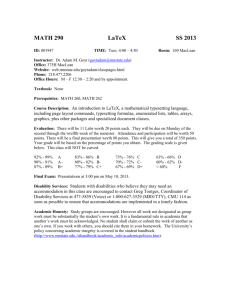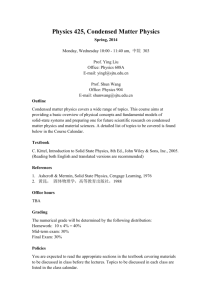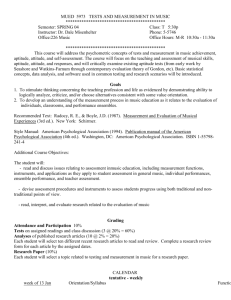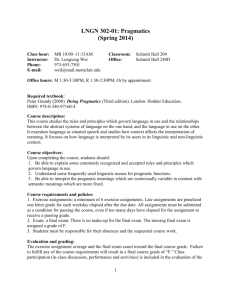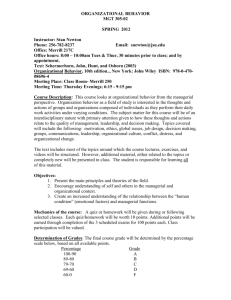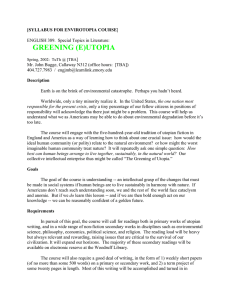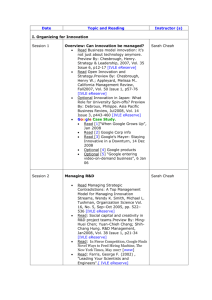Religion 37
advertisement
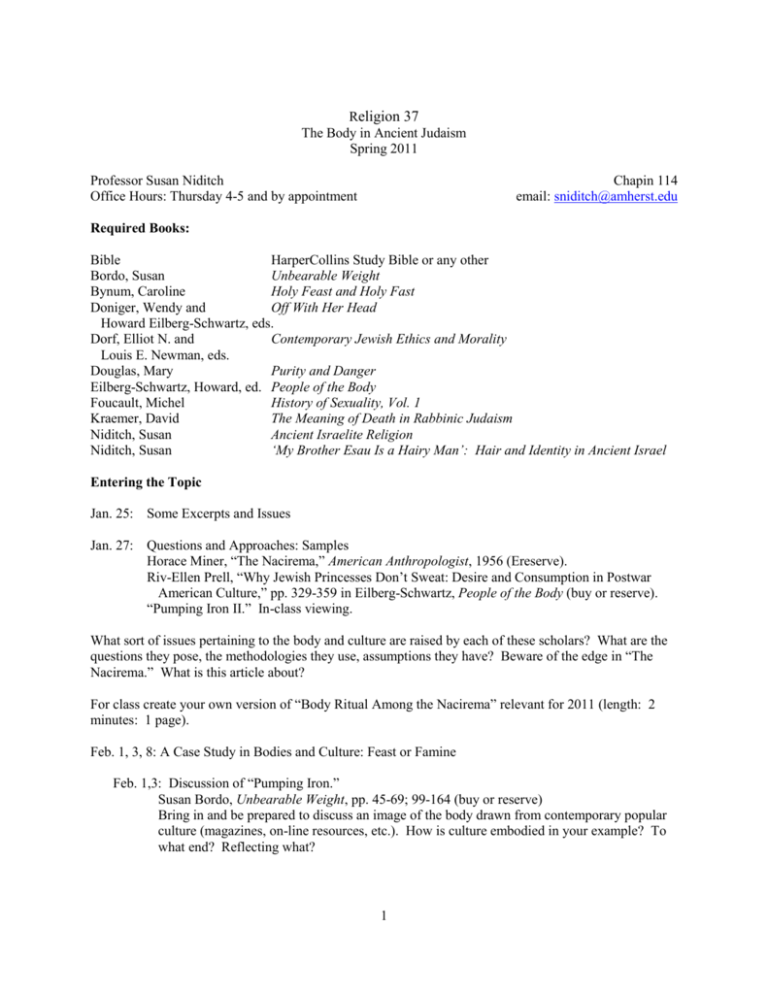
Religion 37 The Body in Ancient Judaism Spring 2011 Professor Susan Niditch Office Hours: Thursday 4-5 and by appointment Chapin 114 email: sniditch@amherst.edu Required Books: Bible HarperCollins Study Bible or any other Bordo, Susan Unbearable Weight Bynum, Caroline Holy Feast and Holy Fast Doniger, Wendy and Off With Her Head Howard Eilberg-Schwartz, eds. Dorf, Elliot N. and Contemporary Jewish Ethics and Morality Louis E. Newman, eds. Douglas, Mary Purity and Danger Eilberg-Schwartz, Howard, ed. People of the Body Foucault, Michel History of Sexuality, Vol. 1 Kraemer, David The Meaning of Death in Rabbinic Judaism Niditch, Susan Ancient Israelite Religion Niditch, Susan ‘My Brother Esau Is a Hairy Man’: Hair and Identity in Ancient Israel Entering the Topic Jan. 25: Some Excerpts and Issues Jan. 27: Questions and Approaches: Samples Horace Miner, “The Nacirema,” American Anthropologist, 1956 (Ereserve). Riv-Ellen Prell, “Why Jewish Princesses Don’t Sweat: Desire and Consumption in Postwar American Culture,” pp. 329-359 in Eilberg-Schwartz, People of the Body (buy or reserve). “Pumping Iron II.” In-class viewing. What sort of issues pertaining to the body and culture are raised by each of these scholars? What are the questions they pose, the methodologies they use, assumptions they have? Beware of the edge in “The Nacirema.” What is this article about? For class create your own version of “Body Ritual Among the Nacirema” relevant for 2011 (length: 2 minutes: 1 page). Feb. 1, 3, 8: A Case Study in Bodies and Culture: Feast or Famine Feb. 1,3: Discussion of “Pumping Iron.” Susan Bordo, Unbearable Weight, pp. 45-69; 99-164 (buy or reserve) Bring in and be prepared to discuss an image of the body drawn from contemporary popular culture (magazines, on-line resources, etc.). How is culture embodied in your example? To what end? Reflecting what? 1 Feb. 8: Continue in Bordo, pp. 165-212; 245-275 Caroline Bynum, Holy Feast and Holy Fast, pp. 113-296 (buy or reserve). For class prepare a two page essay in which you outline three or more key points raised by Bynum and explain their relevance for our study of the body. Altering the Body Feb. 10, 15: Circumcision and Blood Rites S. Niditch, “Introduction to Ancient Judaism,” in Ancient Israelite Religion (buy or reserve), pp. 3-33. Genesis 1-3; 15; 17 Exodus 4:24-26 Genesis 34 Howard Eilberg-Schwartz, The Savage in Judaism, pp. 140-176 (Ereserve and reserve). Feb. 17, 21: Hair Numbers 6: Nazirite vow 2 Sam 14:25-18:16: Absalom Judges 5 (opening lines of the poem); Judges 13-16 (esp. chs. 13 and 16). Niditch, Ancient Israelite Religion, pp. 99-118. Edmond Leach, “Magic Hair,” The Journal of the Royal Anthropological Institute 88/2(1958)147-164 (Ereserve). Niditch, My Brother Esau Is a Hairy Man. Feb. 18: Three Page Essay Due: Applying Body Questions to the Case of Circumcision Saul Olyan and biblical references in his essay, “What Do Shaving Rites Accomplish,” JBL 117(1998)611-622 (Ereserve). Readings in Eilberg-Schwartz and Wendy Doniger, eds., Off With Her Head, to be assigned in class (buy or reserve). Concepts of Clean and Unclean Feb. 24: Food Mary Douglas, Purity and Danger, pp. 1-7; 36-71 (buy or reserve). Leviticus 11 Passover ritual, Niditch, Ancient Israelite Religion, pp. 99-106 (buy or reserve). How does the axiom “you are what you eat” apply to Israelite customs and legal traditions pertaining to food? Prepare a one page response essay for class. Mar. 1: Excretions, Clean and Unclean Leviticus 12, 15 Howard Eilberg-Schwartz, The Savage in Judaism, pp. 177-194 (Ereserve). Danby, m. Niddah (Ereserve). Be sure to print out this text. Chava Weissler, “Mizvot Built into the Body,” pp. 101-115 in Howard Eilberg-Schwartz, People of the Body. 2 Rachel Wasserfall, “Menstruation and Identity,” pp. 309-327 in Eilberg-Schwartz, People. Continuing motifs of clean/unclean, chaos/creation, issues in gender. Mar. 3: Five Page Essay Due on women and uncleanness in Judaism: in-class discussion. Mar. 8, 10: Death: Soul/Body/Uncleanness S. Niditch, Ancient Israelite Religion, pp. 50-69 (and biblical passages cited). The following set of biblical passages: Lev 20:6, 27 2 Kgs 23:24; 10 Deut 18:9-14 Isa 8:16-22 Deut 26:12-15 Isa 28:7-22 1 Sam 28:3-25 Isa 57:3-13 2 Sam 18:18 Isa 65:1-7 2 Kgs 9:34-37 Jer 16:1-9 2 Kgs 21:6 Amos 6:4-7 2 Kgs 13:21 (compare 2 Kgs 4:8-37) Numbers 19: the ritual of the red heifer “Death,” in Encyclopedia Judaica, Vol. 5, pp. 1419-1429, (Ereserve). “Olam Ha-Ba,” (i.e. “World to come”) in EJ, Vol. 12, pp. 1353-1357, (Ereserve). Blackman, mOhalot (Ereserve) Be sure to print out this text. David Kraemer, The Meaning of Death in Rabbinic Judaism. Mar. 12-20: Spring Break Women’s Bodies: At the Margins, Power, Violence, Gender Identity Mar. 21: Viewing of “Basic Instinct,” available on streaming. Mar. 22: Intro: Women Desired/Feared Discussion of “Basic Instinct” English Ballads, Child 81: “Little Musgrave and Lady Barnard,” Child 42: “Clerk Colville” (Ereserve). Keep in mind from Motif Index for the next few classes S262.1: wife given to monster to appease it P214: wife drinks husband’s blood S263.6: wife sacrifice to procure wealth H460 ff.: ties husband to bed so lover can kill him G79.1: animal wife eats husband G250.1: wife is witch K2213: treacherous wife Mar. 24: Read Foucault, A History of Sexuality, pp. 81-131 (buy or reserve). Prepare a one page response. 3 Mar. 29: Judges 4-5 (Jael) Judges 16:4-31 (Delilah) 1 Kgs 16:29-34; 21; 2 Kgs 9 (Jezebel) 2 Kgs 11:1-16 (Athaliah) Mar. 31: Women’s Bodies, War, and Exchange Gayle Rubin, “The Traffic in Women,” in R. Reiter, Toward An Anthropology of Women, pp. 157-210 (Ereserve). Genesis 34, Judges 19-21, Judges 11 Think about “Beauty and the Beast” in traditional tellings; counder motif S262.1. Apr. 5: Woman and Food/Woman and Wisdom 1 Samuel 25 The Book of Esther Proverbs 1-9 C. Newsom, “Woman and the Discourse of Patriarchal Wisdom: A Study of Proverbs 1-9,” pp. 142-160 in P. Day, ed. in Gender and Difference (Ereserve). Apr. 7: No Class Apr. 12: A guest lecture by Professor Janet Gyatso, Harvard University, dealing with the body in Tibetan Buddhist medical traditions, from the perspective of gender and the body--a valuable comparative case study. God’s Body Apr. 14: Eilberg-Schwartz, “The Problem of The Body,” pp. 17-46 in Eilberg-Schwartz, People. Stephen D. Moore, God’s Gym, pp. 75-102 (read biblical passages he cites) (Ereserve). Shiur Komah Naomi Janowitz, “God’s Body,” pp. 183-201 in Eilberg-Schwartz, People. Elliot Wolfson, “Images of God’s Feet,” pp. 143-181 in Eilberg-Schwartz, People. Apr. 14: Two page Reflection Due on God’s body. The Body: Issues in Contemporary Jewish Ethics Apr. 19: No Class . Begin reading the novel assigned for Apr. 28. Apr. 21: Euthanasia Louis Newman, “Woodchoppers and Respirators,” in Dorff and Newman, Contemporary Jewish Ethics and Morality, p. 140-160 (buy or reserve). Fred Rosner, “Euthanasia”; Byron Sherwin, “A View of Euthanasia,” in Dorff and Newman, CJEM, pp. 350-391 (buy or reserve). Apr. 21: A guest lecture by Professor John Reeder, Brown University. Apr. 26: The Case of Abortion Articles by Feldman and Lubarsky in Dorff and Newman, CJEM, pp. 382-402 (buy or reserve). 4 Apr. 27: Viewing of “Star Trek: The Insurrection,” available on streaming. Apr. 28: Discussion of film and Piercy’s novel (below) and issues it raises. Article by Mackler in Dorff and Newman, CJEM, pp. 177-193 (buy or reserve). Novel by Marge Piercy, He, She, It. May 3-5: In-class offerings by all members. Judaism and biotechnology: applications May 5: The Final Essay Due A case study on a topic in Judaism, the body, and biotechnology. The project will be selected in early April in consultation with Professor Niditch. The length of the final essay is 8 -10 pages. 5



